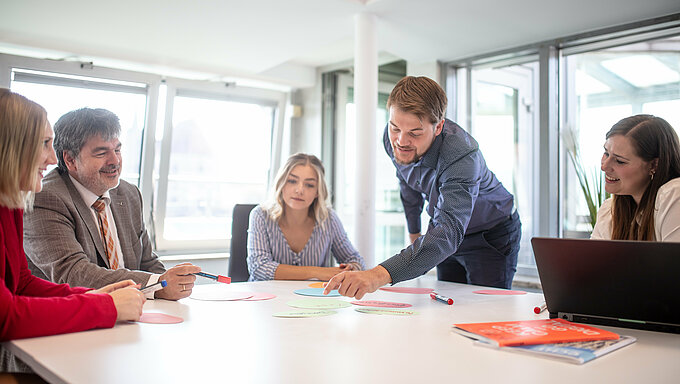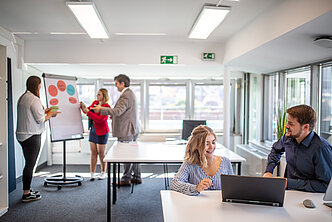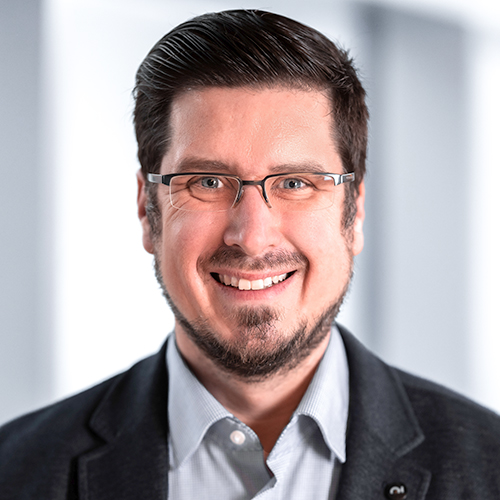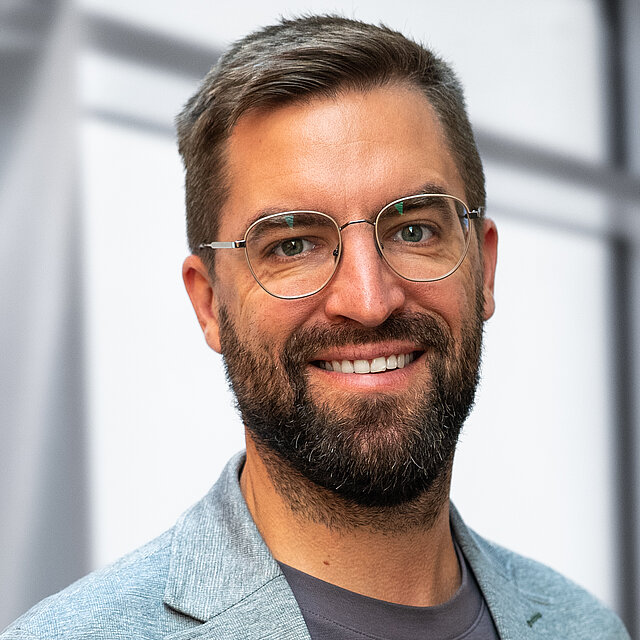
"The great enemy of knowledge is not error, but inertness."
Henry Thomas Buckle
Interdisciplinary approach
Following this guiding principle, our study programs are designed to meet the challenges of the labor market and the general environment through interdisciplinary and transdisciplinary work. In addition, we pay attention to the constant inclusion of potential innovations. Our students are to be sensitized to other structures as well as new technologies; in addition, the topic of start-ups and entrepreneurship is also an important component.
The Bachelor's program in Communication Design, which has already been successfully offered at the Münchberg site for many years, and the Bachelor's in Innovative Healthcare are the first "sprouts" of our new department. In the coming years, our offer will develop into a colorful bouquet of different bachelor's and master's programs and be enriched by application-oriented research.
The new department is committed to the basic principles of Hof University's mission statement. We see ourselves as an interdisciplinary, customer-oriented and resource-efficient division of the university. We want to reduce barriers between disciplines to ensure a high level of employability for our students. At the same time, we want to sensitize them to the careful use of scarce resources and, through application-oriented research, help science to better meet the challenges facing our society and businesses.
Innovative teaching approaches

"In play you can get to know a person better in an hour than in conversation in a year." - Plato
Lego and college? Can they go together? Yes, absolutely! Using the LEGO® Serious Play® methodology makes it possible to playfully foster new ideas, improve communication and speed up solution finding.
The method is used in lectures, for example, to develop new business strategies, to optimize teamwork or to develop solution concepts for specific issues.
Specially assembled LEGO® Serious Play® building sets are used. These contain an extensive selection of Lego bricks that students can use to develop models of their point of view on a wide variety of issues. Brick by brick, the knowledge and experiences of all participants are incorporated into the Lego model and a common understanding of the topic under discussion is developed.

"It took me a few seconds to draw it, but it took me years to learn how to draw it in a few seconds." - Paula Scher
What is meant by design thinking? Design Thinking is a clearly structured, customer-centric, and iterative method for both brainstorming and solving complex challenges. It is based on the assumption that challenges are best approached in an interdisciplinary way, i.e. from different perspectives. The design thinking approach succeeds in jointly developing a superior solution from the customer's point of view. Cost-effectiveness, feasibility and benefits are weighed against each other.
With its open, creative but at the same time systematic approach, the Design Thinking method offers a step-by-step process that gradually approaches the optimal solution to a challenge. The first step is to understand the challenge down to the smallest detail and from different perspectives, both factually and emotionally. On this basis, ideas for solutions are then developed, weighed up against each other, further developed and finally implemented. The result is a sustainable solution, e.g. the development of a new service, an innovative digital product or a target-oriented business model.

"Tell me and I forget, show me and I remember, let me do it and I understand." - Confucius
In business games, participants are confronted with a real-life situation in which they can act and decide creatively and in a self-determined manner. They gain insight into individual challenges and contexts, make their own decisions and learn directly about the consequences of their actions.
How does a business game work?
At the beginning of each simulation, the game leader first explains the case study to be dealt with during the game. Afterwards, each group of players is assigned to a fixed role and receives more background information and tasks for this role. After the initial situation is known, the respective challenge is analyzed within each group, possible options for action of the role are discussed and action strategies are developed.
Once this preparatory phase has been completed, the actual game phase begins, in which the individual groups/roles interact with each other, negotiate and hold discussions in order to jointly search for the best solution. In this phase of the game, the game leader provides specific impulses or directs the action with event cards.
Finally, the most important part of this method begins: reflection. In this phase, the results are presented to the plenum and discussed together. By assuming different observer positions in this phase, the relationships developed during the game phase are analyzed, decisions made are reflected upon, and the effects of the actions are jointly evaluated.
"Perfection is not achieved when there is nothing left to add, but when there is nothing left to leave out." - Antoine de Saint Exupéry
Scrum is an agile project management method that supports collaboration in teams. "Scrum" in rugby stands for "scrum" - and just like a rugby team practicing for the big game, teams using Scrum are able to learn through experience, self-organize in problem solving, and reflect on their successes and defeats to continuously improve.
Our students become active themselves on the basis of Scrum, set themselves goals and work on these in self-organized teams.
The core element of the development method are recurring Scrum Sprints, i.e. defined time periods of constant duration [here: teaching units] in which all learning tasks that are necessary to work on the sprint goal are worked on by the team. Each Scrum Sprint begins with a Sprint Planning, in which the Sprint goal is defined, and thus it is determined which individual tasks (Backlog Items) [here: curriculum content] will be included in this one Sprint and thus become so-called Sprint Backlogs. At the end of each Sprint, the results of the Sprint are compiled, feedback is recorded and the requirements are adjusted (Sprint Review). Subsequently, in the Sprint Retrospective, the working methods of the past Sprint are considered and, if necessary, potential improvements for the next Sprint are derived. Then the next Sprint begins.
The instructor takes on the role of the product owner. He or she specifies which components of the product backlog [here: syllabus] are transferred to the sprint backlog and provides technical support for the sprint, the sprint review and the sprint retrospective. The instructors also create an environment that stimulates learning with a dose of pedagogical composure and humor. For example, the familiar "Definition of Done" in Scrum is supplemented by a "Definition of Fun". In addition, the teacher supports team development and cooperation in the student teams as a kind of Scrum Master.
Usually, learners follow the lecturer's lecture passively during a lecture and then - often at home - work on exercises related to the taught content.
In the Flipped Classroom, things are different. Here, (individual) basic course content is no longer taught on site at the university. Students work through the content asynchronously, independent of location, individually and at their own learning pace using digital learning materials such as lecture recordings, podcasts, written documents, digital scripts and other materials.
The attendance times at the university are used for joint, interactive consolidation with the lecturers. These go far beyond a classic answering of questions and discussions on what has been learned. The knowledge acquired is illustrated using interactive practical examples, or the students put it into practice themselves in experiments under the guidance of the lecturers. In this way, the knowledge learned at home is deepened and applied in practice. The students' engagement with the content therefore takes place where the teachers are there to support them. In this way, higher-value learning goals are achieved together, which go beyond simply remembering and understanding content.

ePortfolios are digital folders in which students document, reflect on, and present their learning and work processes during seminars.
In this way, students continuously deal with the learning content and consolidate the knowledge they have gained. At the same time, with the help of the ePortfolio, they constantly deal with their individual learning success and can close any gaps in their knowledge in a timely manner. If ePortfolios are used as an alternative form of examination, the often stressful end-of-semester phase for students, in which one exam or deadline follows the next, is defused.
During the semester, students prepare the content of each seminar session in their ePortfolio and work on self-selected topics in depth; lecturers support the students technically and in terms of content by providing appropriate feedback in individual or group coaching sessions. There are no limits to the students' creativity. Each student can prepare the content in his or her own way, depending on his or her individual learning style. In addition to text documents, for example, other self-created or researched media such as podcasts, videos or graphics can be embedded.
In principle, ePortfolios can be maintained and expanded throughout the entire course of study in order to document long-term learning processes as well. e-Portfolios also offer students added value for the time after they have completed their studies. For example, relevant excerpts can be added to the application portfolio to support the skills described in the cover letter.

What is meant by working-out-loud (WOL)? In a nutshell, this learning method is about proactively making one's own knowledge visible in such a way that it can help others.
Members of a WOL Circle meet once a week for one hour within 12 weeks in a protected environment to discuss a specific topic, e.g. a defined learning goal. Each of the 3-5 participants openly contributes his/her individual knowledge and ideas and shares them with the network. The WOL Circle Guide supports this process. It contains the objectives and tasks of each meeting and provides a structure.
Working-out-loud is not only a way of working, but also an attitude towards work. Participants in a WOL Circle break away from the classic idea that knowledge is power and should only be passed on to a certain extent in order not to lose one's own status. In WOL, knowledge is shared freely in the sense of mutual learning and joint further development. Each member of the Circle has the opportunity to work on his/her individual goal with the help of the other participants and at the same time to support the other group members with his/her knowledge and experience.
At a barcamp, many different people come together to discuss common interests.
In a round of introductions, the participants freely offer questions or topics. From trainees to students to professors and/or entrepreneurs, each individual can be an expert with his or her own perspective. If there is sufficient interest in a question or topic, it is assigned to a session and allocated to a room and a time frame (session planning).
The form in which the topics are subsequently dealt with is entirely up to the experts. They can be treated e.g. in lectures, workshops or also open discussion rounds. Each participant is free to contribute and share his or her individual knowledge.
Barcamps serve the exchange of experience and knowledge and the expansion of networks. Questions, ideas or projects can be discussed openly with other experts and many new impulses can be gained.
In order to give students an insight into their future professional practice, interdisciplinary, practice-oriented project work / company projects are part of the study program. The aim of these is to enable students to apply and further develop the knowledge they have acquired during their studies in real problem situations.
Through contacts with the business community, students have the opportunity to work on projects with companies before their internship and to establish initial contacts with potential employers.











